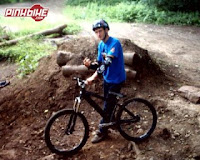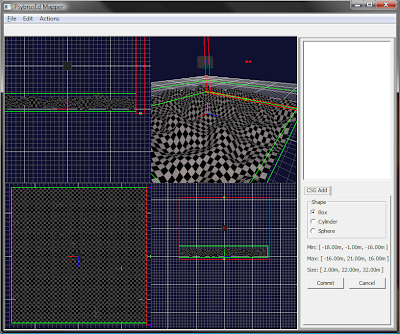 When I was in high school, I spent a large amount of time outside of programming out dirt jumping. Since then a few things have changed, and I have since stopped, not for good, but until I get myself sorted financially and can start to plough money back into buying a decent mountain bike!
When I was in high school, I spent a large amount of time outside of programming out dirt jumping. Since then a few things have changed, and I have since stopped, not for good, but until I get myself sorted financially and can start to plough money back into buying a decent mountain bike!A few friends used to always bug me to make a DECENT mountain bike game, and at the time I laughed it off knowing how difficult an undertaking it would be, especially since I didn't have a firm grasp on C++, and my only real projects were Half-Life mods. A few years have passed since then - in that period of time I've gotten myself a degree, a CyTech NVQ and a job in the games industry.
In my first year of university, one of our modules was games design. The project for this was essentially write a full game design document. We had over 3 months to do this but I had a small problem - I had no ideas AT ALL. Come the week before hand in, I actually started to get some ideas, and the night before it was due in, I threw together a full design document, weighing at around 50-60 pages, for a game called 'Freecross Frenzy'.
'Freecross Frenzy', as you've probably guessed by now, is a mountain bike game. The idea was pretty much to combine dirt jumping with dual slalom and 4x. The mechanic of the game was to score points by not only completing a race in a good position, but to perform stunts whilst racing, and basically style your way to the finish line. Very simple concept, however without experience, I was unable to ever consider knocking together a tech demo. The reason I've wanted to put a tech demo together was mostly because of my idea for the control mechanism - Weight shifting. The emphasis for doing tricks in games such as Tony Hawks is focused on button combinations, which is all well and good, it gives you a pretty straight forward interface to work with, and lets you do combos with great ease. The problem? Lack of freedom. By giving the gamer control of the rider's position on the bike, it allows them to perform tricks that haven't explicitly been implemented by the programmer - encouraging emergence.
Back to the plot though, I've decided to start putting together a tech demo - nothing fancy looking, not a full game, pretty much just a track, the control system, and the physics behind it all. The physics and controls are everything for this - so theres a lot of work I need to do before I get started on the demo. This includes finishing the last couple of bits in Mapper so I can throw together a track, as well as starting AND finishing another part of PsybrusEd - Rigger. Rigger will be a simple tool I use to bolt together models with constraints, and in this case, connecting the wheels, frame and fork of a mountain bike with the correct constraints! I'm giving myself another week to get the Mapper sorted and up to spec to start lashing out levels, and then I can start properly on Rigger.
And before I go, a quick update on PsybrusEd Mapper. Height fields are in, they can't be edited yet, but they can be dropped into the world, so that's one more thing out of the way! Undo and redo are now bound back in since I've shuffled around the events a bit, and also fixed the threading problems I was having. The game is now fully updated from Python, however, the renderer sits on its own thread still so it doesn't cause the GUI to slow down - its also locked at 30FPS to keep CPU usage low. Action panels are in and working, and object selection/deselection is fully working too!

Next hurdle to jump is to get object editing working - which would include:
- Transforming objects (Translate, rotate, scale, etc)
- CSG specifics such as clipping objects.
- CSG specifics such as clipping objects.
- Heightfield specifics such as painting the heights.

No comments:
Post a Comment